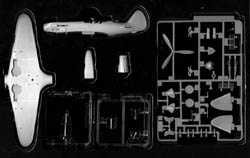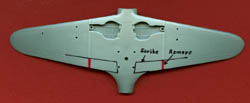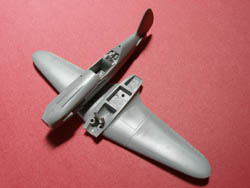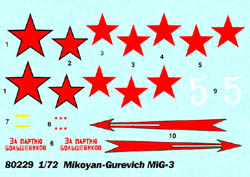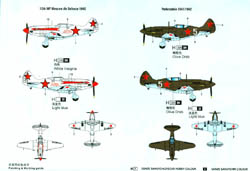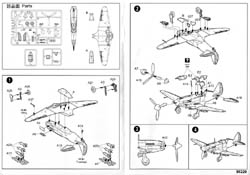Hobby Boss 1/72 MiG-3
|
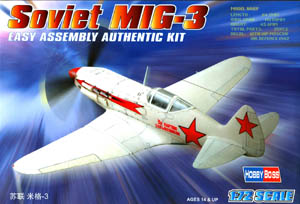 |
Introduction
In 1939, following the poor performance of their airplanes in both Spain
and China against German, Italian and Japanese airplanes, the Soviets
decided they needed a very fast fighter capable of operating at very high
altitudes to counter an anticipated high altitude strategic air assault
from Nazi Germany. They were probably misled into believing this by German
high-altitude photo-reconnaissance flights over their territory using
Ju 86Ps. Polikarpov’s “Kh” fighter, then in preliminary
design, was chosen for development to meet this need.
A new design bureau (OKB) was set up to be run by the 33 year old Armenian
engineer Artyom I. Mikoyan with 49 year old Mikhail Gurevich as his deputy
and the building of three prototypes was authorized. The “Kh”
fighter prototype was given the designation I-200; the “I”
represents “istribitel” (fighter). At this point, Polikarpov
ceased to have anything to do with this airplane, as the new OKB had fully
separated from Polikarpov. The 1,350 hp Mikulin AM-35A liquid cooled vee-12
was chosen to power the I-200 instead of the preferred AM-37A as the latter
was having troubles in development and a reliable engine was essential
to the program’s success.
The first I-200 flew on April 5, 1940. On the eve of the first production
order an I-200 achieved a top speed of 404MPH (651 Km/H) at 23,000’.
The production airplanes were designated MiG-1. Early testing showed both
the I-200 and the MiG-1 to be longitudinally unstable, to handle poorly
about all three axis and to snap into a spin without warning from steep,
high-speed turns; further, the “reliable” engine was extremely
temperamental. The pilots, seated directly above the radiator, complained
they were being cooked like fish in a stew. The MiG bureau came up with
many design tweaks incorporated in production to create the MiG-3. Our
Publisher has explained to me why all the MiGs were odd numbered. “Even
digits generally denoted bombers, while odd numbers fighters. Mikoyan
and Gurevich were inexperienced with bombers, thus the odd-numbered line
of aircraft from that OKB (MiG-1, 3, 9, 15, 17, 19, 21, 23, 25, 27, 29,
and 31). Gaps in the series are generally for aircraft designed, but not
built because they lost out to other designs.”
All of these changes were good but not enough to make the MiG-3 a pilot’s
airplane; it was still difficult to fly. The airplane was designed for
one mission, high-altitude interception, and was thrown into another,
frontal fighter operations at low to medium altitudes. At those altitudes,
the MiG-3 was out of its element and suffered accordingly. At altitude,
though, many a German pilot discovered just how lethal the plane was,
and above 16,000’ (5000 M) avoided it at all costs.
The last of 3,322 MiG-3s was delivered in spring 1942. At the peak of
production they were being turned out at the rate of 562 per month!
[NB: Our publisher, Chris Banyai-Riepl, a Russian history major, provided
a lot of help with the history above.]
The Kit
This new line of kits from Hobby Boss, a subsidiary of Huihuang Electric
Appliance Co., Ltd. is different! They are about halfway between contemporary
Snap-Tight kits and conventional kits in engineering and require about
half the work of a conventional kit to build Out-Of-The-Box. From my quick
research the kit appears to be acceptably accurate. There is, however,
an easily corrected error that should not be left unattended to. Hobby
Boss has the covers for the inner/outer wing panel joints wrapping all
the way round the wing. The covers should end at the leading edges of
the flaps. It will be easy to carve off the excess cover and scribe the
flap outlines.
The 35 parts – four in clear and 31 in gray styrene are firmly
located in the box by being clipped into a vac-formed tray insert. The
fuselage, sans radiator and chin is in one piece, which includes the cockpit
detail. All you really need to add is an instrument panel and seat belts
from your spares box. I will use printed-paper sidewalls and an instrument
panel from the defunct Modelaid magazine. As you can see from the parts
scan, you have the choice of modeling the canopy open or closed.
The instructions and decals provide for two color schemes. I think Hobby
Boss can easily and cheaply improve this kit, and their others, by adding
instrument panel, cockpit sidewalls and seat belts to their decal sheet.
Conclusion
I salute Hobby Boss for this innovative approach to an easily built
kit, marketed at a reasonable price. Maybe this approach to kitting will
bring more, and younger, modelers into our hobby. Give ‘em to your
kids and to your grand kids. You should buy one of these, if for no other
reason than to see for yourself what it’s like. It is different.
The presentation, the instructions and the contents are all first rate.
AMSers need not apply.
I paid $9.00, plus sales, tax for my kit at Emil Minerich’s Skyway
Model shop in Seattle
References
-
Air Enthusiast Quarterly – Eighteen, 2nd Quarter 1982: In
depth article, Quest for Altitude…The First Generation MiGs
by the editors. This, although containing many errors, is the best
single source reference that I found.
-
Scale Aviation magazine. I don’t know the issue of this Japanese
magazine containing three pages of very well done, detailed drawings.
-
Replic magazine from France; issue unknown. A very well illustrated
build-article on ICM’s 1/48 MiG-3.
-
War Planes of the Second World War – Fighters, Volume Three:
William Green, Doubleday, UK, 1961, no ISBN or Library of Congress
reference.
-
Aeroplane magazine: February 2004; long article on Russian restorations.
November 2005; mention and photo of the first MiG-3 recently restored.
April 2006; The Fighter that Came in from the Cold – a recovery.
October 2006; mention and photo of one of the recently restored MiG-3s
preparing for flight.
|
|

